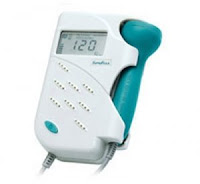Electronic fetal monitoring for low-risk women in most out-of-hospital births, and for many midwives and doctors, is commonly done intermittently. The baby's heart rate is heard through a
Fetal Doppler both during and after contractions, or for short-term periods with the
fetal monitor attached to the delivering mother. Some baby heart beat monitors can be used underwater, and this new technology frees the mother to use a tub or a shower to increase comfort.

I have a friend who is a midwife with her own delivery clinic had told me that at the hospital and at the birth center, they carefully monitor the patients through intermittent monitoring during and after contractions, and they observe the amniotic fluid, the mother's temperature, and other signs.
She also recounts an experience with one of her patients she told me that this patient of her was induced during her first pregnancy because her baby was large. After a day of labor, the fetal monitor showed the heart rate decreasing during contractions, and she had a cesarean section. When the patient was attempting a VBAC (vaginal birth after cesarean) and being induced with her second child, she was very frustrated by all the "attachments"-the IV, the epidural and, worst of all, the tight straps of the monitor belts.
Nevertheless, her patient understands the importance of all of this technology and feels that it was necessary in her case. And my friend remember her patient saying that the most important thing in labor is that you know the baby is okay and that you have a trusting support groups.
Well you can really be sure that the baby is okay if the hospital or birth center that you are in uses only highly recommended fetal monitor device that can deliver accurate results. My midwife friend is very proud that in her clinic, they use only
Cadence II Dual Fetal Monitor (Twins FHR), and no other. This exceptional
Fetal Monitor is yet another lightweight, space-saving baby heart monitor, with its external and internal monitoring parameters ensure that it can be used up to and during the second stage labor. The said equipment also can be connected to the MFM-CNS obstetrical central station to construct central monitoring system.
The said
baby heart monitor has a dimension of 330mm x 270mm 100mm and 3.5 kgs. of weight and it s compact design, it can easily move or mounts on walls. This baby heart beat fetal monitor, with folding up features of 5 inch screen, with the use of a Multi-crystal high sensitive watertight probe, is a waterlight high sensitive untrasound transducer. Because of the waterlight flat TOCO transducer, its flat surface design reduces visible mark and enhances comfort.
The Automatic Fetal Movement Detection (AFM) uses a pulse doppler ultrasound technique, with a range of 0-100% and one percent of resolution, while the marking feature utilizes manual fetal movement mark. This fetal monitor device can detect fetal movement by ultrasound transducer automatically. It also has Intrapartum Monitoring, with optional DECG and IUP function. Aside from its nine elements high sensitive probe, it also has the Optional Dual FHR monitoring (Twins FHR).
The Built-in network/PC connecting interface of the product is compatible with wireless and cable LAN obstetrical central station. It is also has a great use in CPT code 59025 (Fetal non-stress test). And because the condition of this equipment is brand new, the manufacturers had offered a 2-year warranty, with an extended warranty plans available including free loaners and their exclusive Rapid Response Service.
Because this
baby heart rate monitor offers the economics of a low cost unit with many of the high end features needed to care for your patients, it is very ideal for the private practice or small clinic.
This
cadence fetal monitor, have Signals Overlap Verification which reduces the risk of heart rate signal from the same source, thus differentiating the heart rate of the mother from the child, in addition to its Insight Software for data transferring and displaying on a standard PC. And lastly, software included has these following features: real time transmission, event and comment record, and patient information management, printout on A4 paper and patient data storage and review.
Read more fetal doppler and monitor reviews at the following websites:















